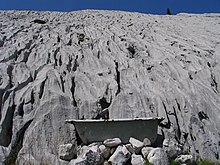Schrattenkalk Formation
The Schrattenkalk Formation is a lithostratigraphic unit of the Cretaceous Period in the Helvetic Republic on the northern edge of the Alps in Switzerland , Austria (in Vorarlberg ) and Germany (from the Allgäu to the Tegernsee - Schliersee region ). Its name is derived from the Schrattenfluh , a mountain range in the Swiss Prealps in the canton of Lucerne , which forms rough or shady weathered surfaces. The term Schrattenkalk was first used by Bernhard Studer in 1834 .
Synonyms are: Hieroglyphic limestone , Calcaire à Hippurites, Urgonia , Rudistenkalk , Urgo-Aptien, Schrattenschichten, Requienenkalk, Rhodanien, Caprotinenkalk, Urgonkalk.
In the lying area, the rocks are bounded by the Tierwis formation and in the hanging wall by the Garschella formation . The total thickness in the Helvetic Republic of Switzerland can be up to 300 m, but decreases towards the east, so that in the Allgäu and Bregenzerwald it is 60 to over 100 m, and on the Schliersee up to 90 m. The width of the occurrence also decreases from west to east, so that only a few isolated occurrences are found east of the Allgäu to Schliersee.
Subdivision
Switzerland
The formation is further subdivided in Switzerland as follows:
1. Lower Schrattenkalk
Age: Early Barremium to Lower Aptian
Light gray, weathering, bioclastic-oolithic shallow water limestone. Typical fossils are rudists , brachiopods and bivalve algae , numerous microfossils and red and green algae .
2. Rawil member, obsolete: Orbitoline layers
Age: Aptium
Well-layered, brownish to black-gray limestone banks, alternating with marl layers and bulbous layers. A rhythmic sedimentation with several small regressions and transgressions is assumed to be the cause of these alternating positions . During the regression, the proportion of detritic sedimentation increased. So sometimes sandstone banks are embedded. The bulbous layers can be interpreted as deposits near the coast with greater flow energy of the water.
Typical fossils: In addition to the lower Schrattenkalk there are sea urchins and , more rarely, corals . Orbitolins ( foraminifera ) are particularly characteristic .
On the south side of the Pilatus (locality: Chilchsteinen 1865 m above sea level ) a fossil root soil, probably from a mangrove-like vegetation, could be detected. This confirms beside the high Detritusanteil the bankside depositional environment.
3. Upper Schrattenkalk
Age: Aptium
light gray to wheathery, bioclastic - oolithic shallow water limestone .
The fossil content is comparable to that of the lower Schrattenkalk, whereby v. a. Bivalvier (Toucasien, Requienien and oysters) can occur more frequently. In addition, corals, lime sponges and algae bulbs can be found again and again.
Austria and Germany
In the Allgäu and Bregenzerwald, the Swiss division can still be maintained, but the boundaries can only be determined with a few meters of uncertainty in the profile. The deposits in the Tegernsee-Schliersee area, on the other hand, represent rocks with a microface that cannot be found further west, so that here the character of the deposit area is assumed to be different.
Occurrence
The type profile on the Schrattenfluh is unsuitable as only the lower part of the formation is present. A description of the formation on Berg Lopper , for example in the Hellegg quarry (667.850 / 203.050), would be suitable .
The formation of Schrattenkalk in very shallow water is also documented by dinosaur tracks ( Iguanodon ) on layer plates in the Risleten quarry near Beckenried . Periodically, this shelf area must also have dried up.
The Schrattenkalk of the chalk, like the Malmkalk and Dogger of the Jurassic period, forms distinctive 50 to 200 m high rock walls when the layers are flat, and climbing ridges when the layers are steep.
Examples of mountain peaks made from Schrattenkalk are, in addition to the Schrattenfluh, the Kreuzberge in Alpstein , the Argentine in the canton of Vaud between Les Diablerets and Grand Muveran and the Bockmattli in the canton of Schwyz east of Lake Wägital . In the Kleinwalsertal , the Schrattenkalk north of the Hohen Ifens forms the 25 square kilometer Gottesacker plateau , which is an impressive karst landscape .
literature
- Kristina Schenk: The Drusberg and Schrattenkalk Formation (Lower Cretaceous) in the Helvetic region of the Bernese Oberland. Dissertation University of Bern, 1992.
Web link
- Entry Schrattenkalk-Formation in the Lithostratigraphic Lexicon of Switzerland
Individual evidence
- ^ A b c Wolfgang Zacher: The Helvetic between the Rhine and Iller (Allgäu - Vorarlberg) . In: W. Zeil (Ed.): Geotectonic research . No. 44 . Swiss beard, Stuttgart August 1973, p. 1-74 .
- ^ A b Herbert Scholz: Building and Becoming the Allgäu Landscape . 3. Edition. Schweizerbart, Stuttgart 2016, ISBN 978-3-510-65333-1 , p. 97-102 .
- ↑ a b Herbert Hagn: The Bavarian Alps and their foreland in a micropalaeontological perspective . In: Bayerisches Geologisches Landesamt (Ed.): Geologica Bavarica . tape 82 . Munich 1981, p. 41-43 .
- ↑ Neues Jb. Der Min., Geogn., Geol., Petr., 1834, Issue 5, p. 512
- ↑ Lithostratigraphic Lexicon of Switzerland, see web links
- ^ Wolfgang Witt: The Helvetikum am Schliersee . In: Bayerisches Geologisches Landesamt (Hrsg.): Explanations for the geological map of Bavaria, sheet no. 8237 Miesbach . Munich 1968, p. 184 .
- ↑ Viktor Steinhauser: Geology of the Eastern Pilatus Group . Diploma thesis ETHZ, 1981.
- ↑ Geology of the Canton of Uri. Altdorf 2011, p. 67, ISBN 978-3-03302916-3
